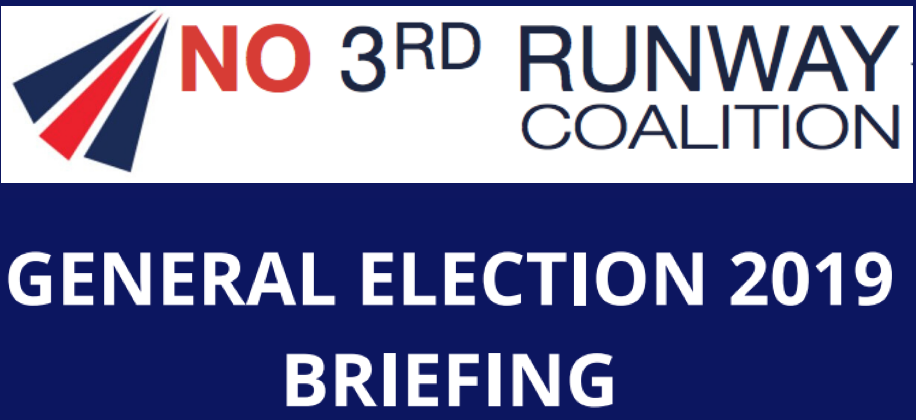Heathrow growth – election briefing (one page) from the No 3rd Runway Coalition – check your candidates’ views
The No 3rd Runway Coalition has put together a simple one-page briefing on Heathrow and its proposed new runway, to help people quiz their parliamentary candidates, and check they know the real facts. The Coalition says: “Supporting Heathrow Expansion comes at the expense of the regions and to the UK as a whole. Here’ s why it should be opposed.” The briefing deals with the Economic costs, the carbon implications, noise, air pollution, transport impacts, and connectivity. Lots of key points, including on economics: ” The Government’ s own economic analysis found that once all negative impacts are monetised, a third runway could bring net NEGATIVE economic benefits to the UK overall in the long term. There is no explicit job model and no clear job creation analysis included in the Airports National Policy Statement. Many of the few jobs created will be low-skilled and short term. The costs of the project are now expected to rise to over £31bn, increasing Heathrow’s debt from £11bn (2014) to over £40bn in 2028. This could still increase further.” On noise: “Data from the CAA reveals that 2.2 MILLION people would experience an increase in noise from an expanded Heathrow.”
.
Tweet
GENERAL ELECTION 2019 BRIEFING – Heathrow 3rd runway
Supporting Heathrow Expansion comes at the expense of the regions and to the UK as a whole. Here’ s why it should be opposed.
ECONOMIC COSTS
- The Government’ s own economic analysis found that once all negative impacts are monetised, a third runway could bring net NEGATIVE economic benefits to the UK overall in the long term.
- There is no explicit job model and no clear job creation analysis included in the Airports National Policy Statement. Many of the few jobs created will be low-skilled and short term.
- The costs of the project are now expected to rise to over £31bn, increasing Heathrow’s debt from £11bn (2014) to over £40bn in 2028. This could still increase further.
CLIMATE CHANGE
- Heathrow is already the biggest single source of carbon emissions in the UK and expansion will add an extra 8-9 megatonnes of CO2 per year. Thus, a third runway is not compatible with the UK’ s legally binding climate targets.
- The Committee on Climate Change has advised the Government to limit growth in passenger demand to 25% between now and 2050. The Government currently anticipates twice this level of passenger growth.
- While the CCC model assumes 31 megatonnes of CO2 by 2050 from aviation, the Government’ s forecasts are that with Heathrow expansion, UK aviation emissions would be as high as 40 megatonnes annually by 2050.
- Consequently, growth would need to be curbed at all other UK airports if a third runway is built in order for the UK not to breach its carbon targets.
AIR POLLUTION
- The Government accepts Heathrow expansion would have a “ significant negative ” effect on Air Quality.
- Government has provided no evidence to show how Heathrow can expand and comply with legal limits and there are currently no enforcement methods should Heathrow not meet legal requirements.
- The area around Heathrow is the second major hot spot for nitrogen dioxide (NO2) pollution in London, with breaches of legal limits having been recorded close to the airport for many years.
NOISE
- Expansion would result in an additional 285,000 flights each year or over 700 extra flights per day.
- Data from the Civil Aviation Authority reveals that 2.2 MILLION people experience an increase in noise from an expanded Heathrow.
- Transport Select Committee concluded that 323,684 people will be newly affected by noise from Heathrow.
- Hundreds of thousands of school children across the South East are already exposed to aircraft noise above 54 decibels, the sound level threshold which has a negative effect on children ’ s behaviour, memory and learning.
TRANSPORT IMPACTS
- Expansion would result in a total of 175,000 additional daily trips on local transport networks.
- Heathrow has to increase the proportion of passengers accessing the airport by public transport from 40% today to 50% in 2030 and 55% in 2040. However, it has only increased this figure by 1% since 2009.
- It is unclear what the cost to the taxpayer of the road and rail infrastructure will be. Estimates of these are up to £18bn, which could easily overrun. Heathrow has only committed to contributing £1bn.
CONNECTIVITY
- Regional Airports will lose 17 million passengers by 2050 if Heathrow expands.
- Transport Select Committee found that expansion at Heathrow would result in 170,000 fewer flights at regional airports by 2050.
- The UK Government currently funds three Public Service Obligations (PSOs) into London airports.
- The total annual subsidy in 2017 for PSO’ s was £10,564,194. The average annual cost of existing PSOs in 2017 was £480,191. 50% of this cost is met by local authorities.
See link for original text

